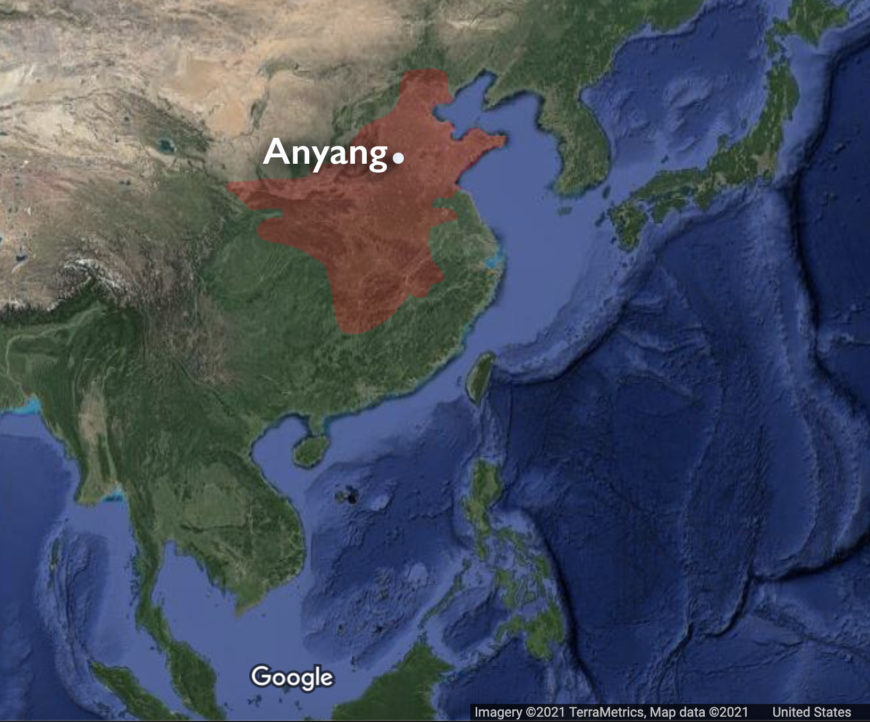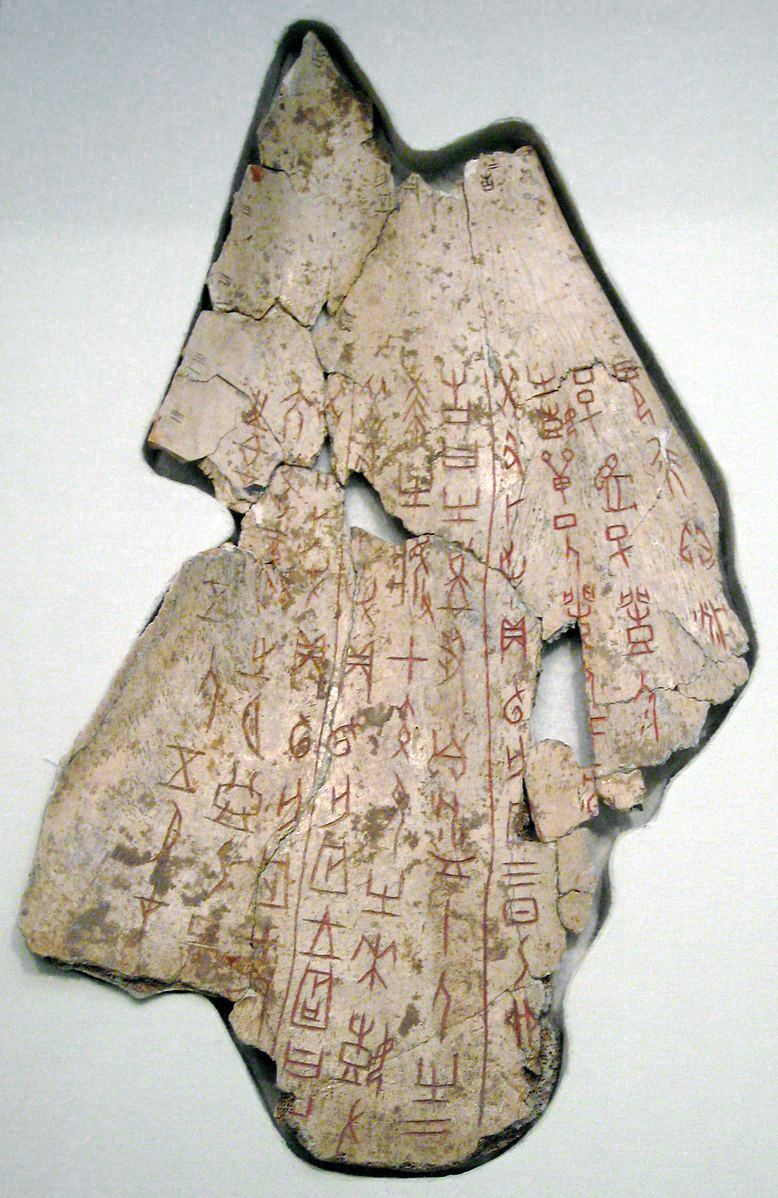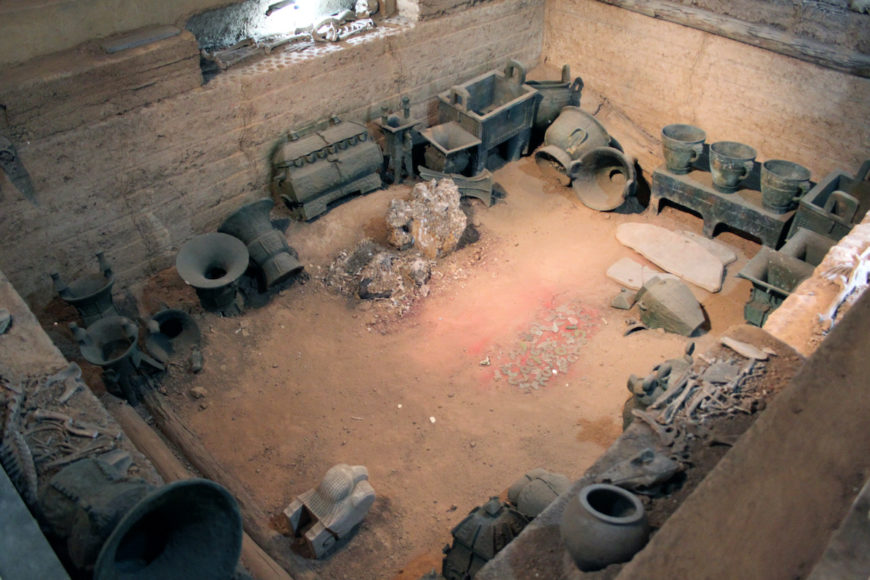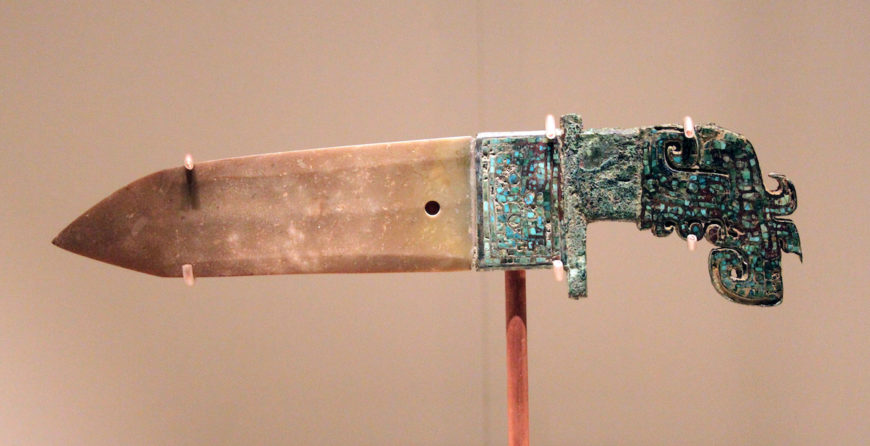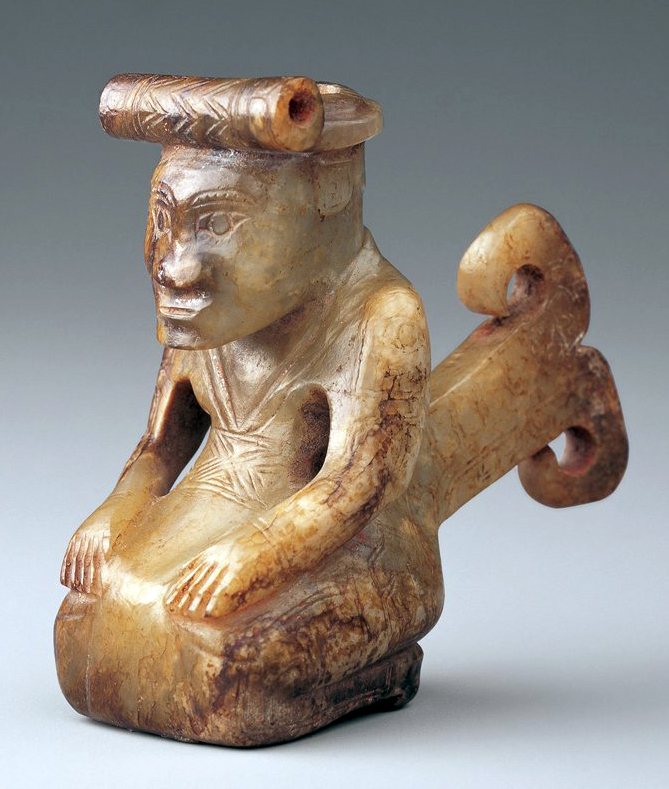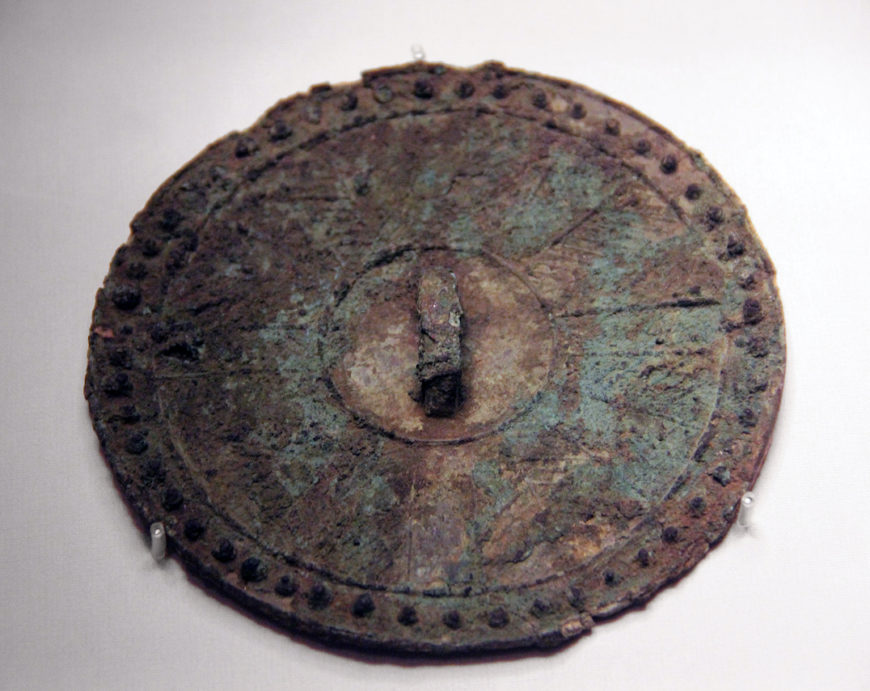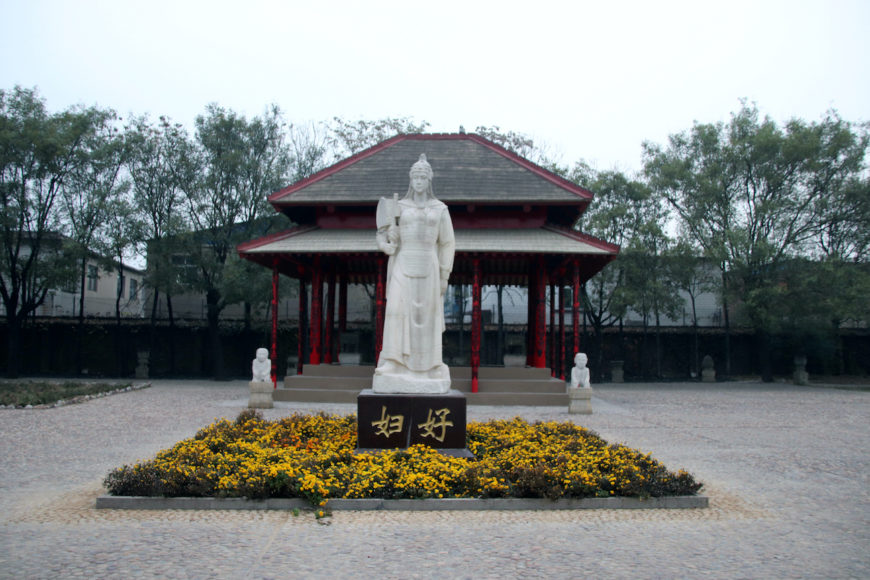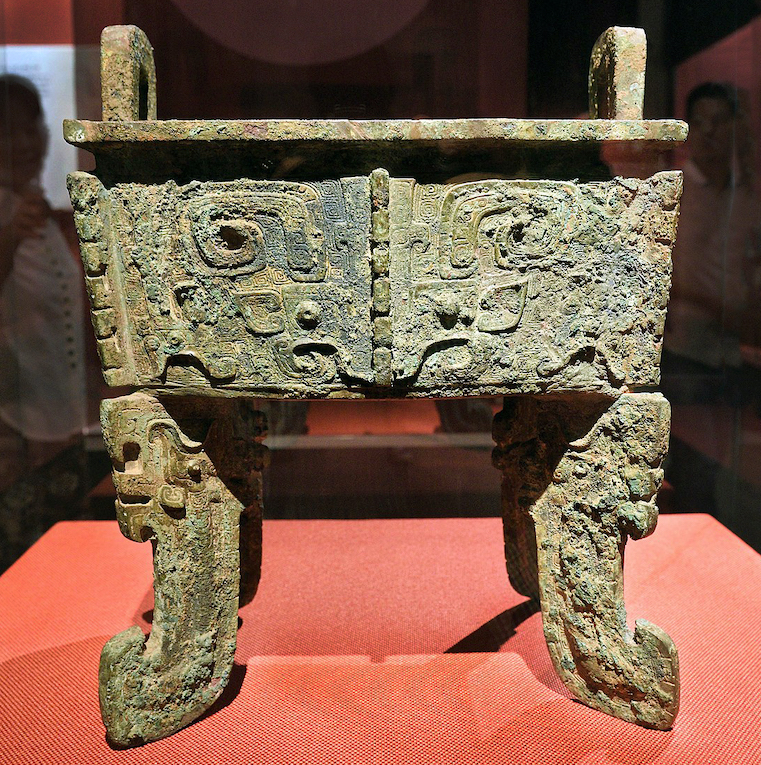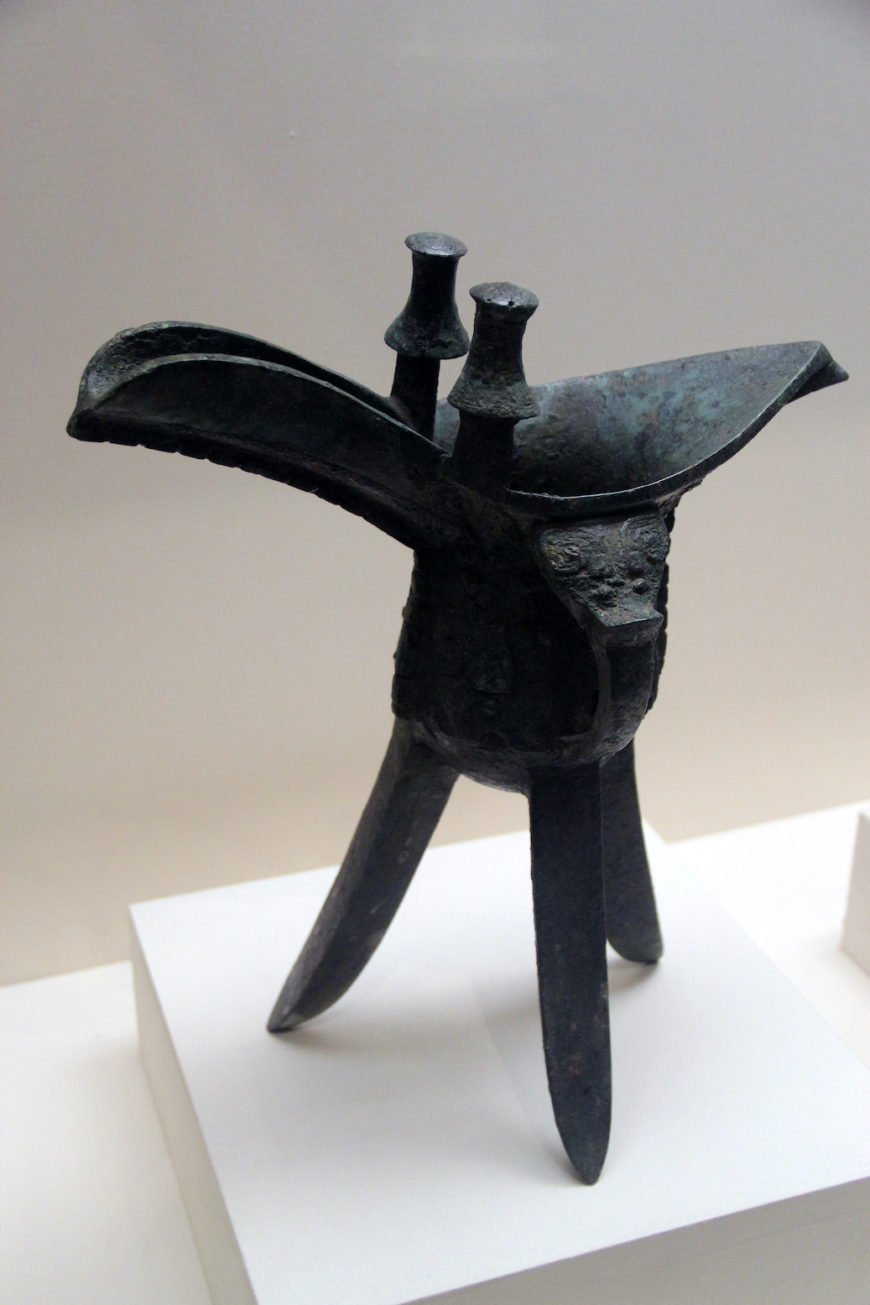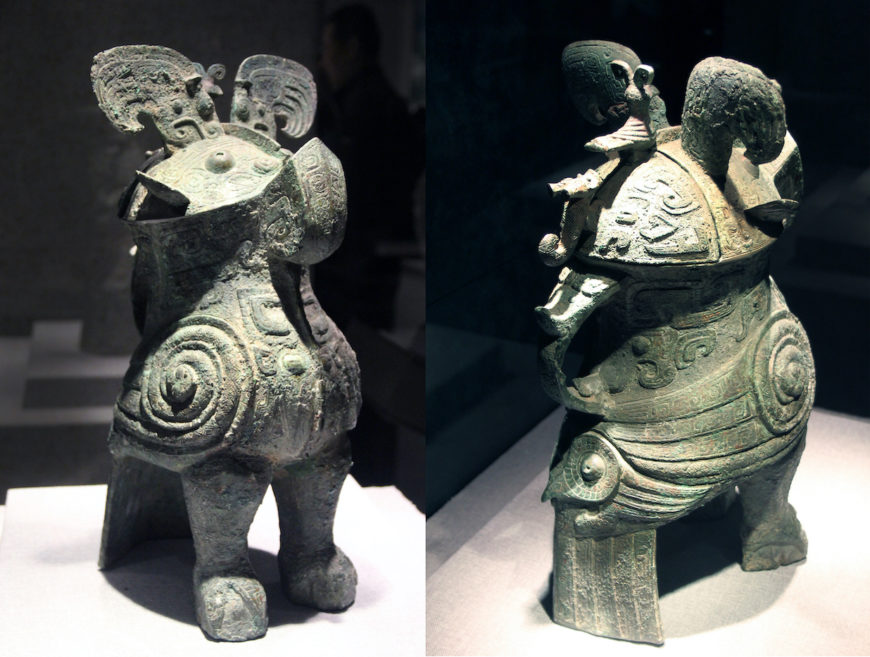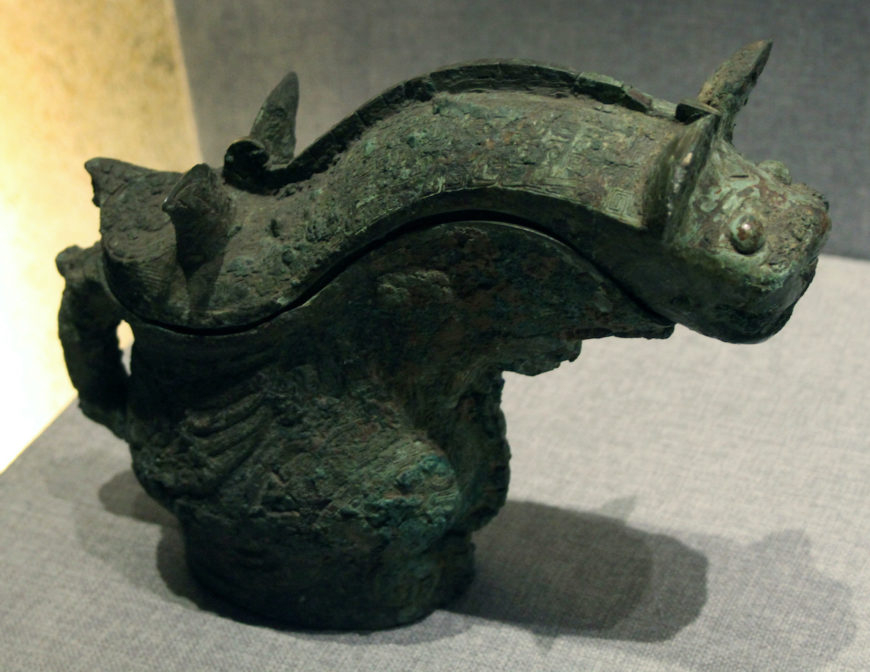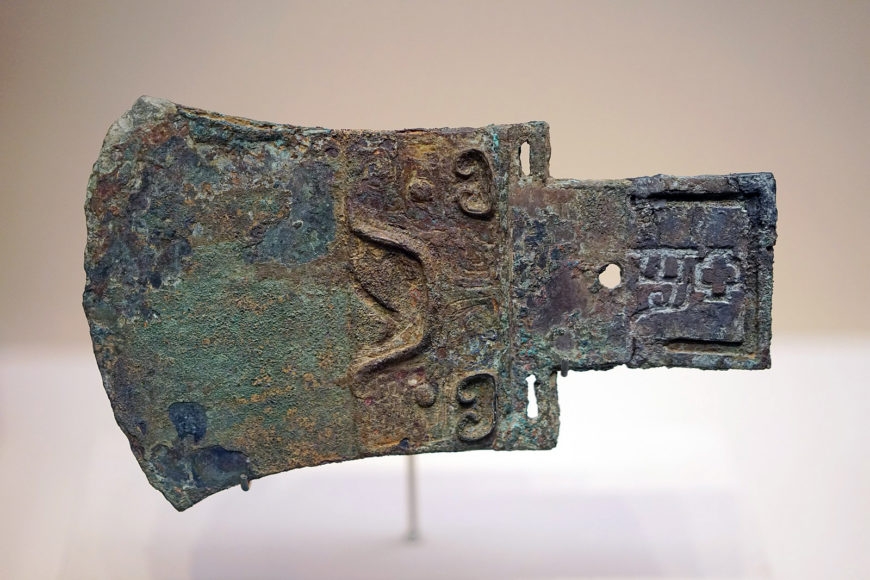Modern sculptural representation of Fu Hao at the Tomb of Fu Hao (Tomb 5 at Xiaotun), Yinxu, Anyang, Henan, China (photo: Gary Todd, CC0 1.0)
Who was Fu Hao?
Military commander, landowner, administrator, royal consort, and mother of the heir to the throne—the warrior-queen Fu Hao (or Lady Hao) is one of the most extraordinary women in the history of the ancient world. Fu Hao, who lived during the 13th Century B.C.E., was one of three royal consorts of the twenty-first king of the Shang dynasty, Wu Ding, who ruled from the last Shang dynasty capital at Yin located in modern day Anyang, in Henan province.
The story of Fu Hao’s remarkable life can be pieced together from objects found in her lavish tomb near Xiaotun in Anyang, as well as inscriptions on tortoise shells and ox scapulae (sometimes called “oracle bones”) used in divination ceremonies performed by her husband Wu Ding.
From these “oracle bone” inscriptions, we learn that Fu Hao was not only a royal consort and mother of the heir apparent, but she also held a high status as a military general second in command to the king. With the most important generals in Shang history under her command, she led thousands of troops in successful military campaigns against hostile tribes beyond the Shang borders. She also participated in sacrificial rituals to appease the ancestral spirits whom the Shang believed influenced every aspect of their lives. Graphic inscriptions on oracle bones and objects found in Fu Hao’s tomb illustrate how she captured her enemies in battle and sacrificed them to her ancestors through cooking, beheading, burning, and boiling them alive.
Oracle bones
An oracle bone from the reign of King Wu Ding (late Shang dynasty), but not from Fu Hao’s tomb, c. 1200 B.C.E., Anyang, Henan Province, China (National Museum of China; photo: BabelStone, CC BY-SA 3.0)
Before Fu Hao’s tomb was discovered in 1976, we only knew her name from the oracle bone inscriptions discovered at Xiaotun in Anyang. Oracle bones, many of which have been reassembled from fragments, give us invaluable information about Shang society and religion during the late Shang (1200–1000 B.C.E.), especially the hopes, fears, and preoccupations of the late Shang kings.
Beginning with King Wu Ding, the late Shang kings attempted to communicate with their ancestors and Di (the high God) through oracle bone divination to predict the future. They used turtle plastrons and bovine scapulae that were polished and drilled with small hollows on one side. When heat was applied to the hollows with a hot poker, the bones would crack on the other side. During the divination ceremony, the diviner spoke a charge (proposition) that conveyed the king’s concerns or something he needed to know. The charge was spoken in pairs, in the positive and the negative, such as “Fu Hao’s childbirth will be auspicious” and “Fu Hao’s childbirth will not be auspicious.” With each charge the hot poker was applied to a hollow and the bone cracked, making a dramatic “puck!” sound. The king (and occasionally the diviner) then read and interpreted the cracks. After the ritual was over, a scribe engraved a record of the divination on the bone, including the date, name of the diviner, topic of divination, and sometimes a prognostication and a result (if we are lucky!).
The Shang kings at Anyang divined about numerous topics of concern from sacrifices, military campaigns, and hunting expeditions, to weather, agriculture, sickness, dreams, and childbirth. King Wu Ding, who is responsible for the majority of divination records, frequently divined about Fu Hao, both while she was alive and after her death when she became a royal ancestor. In the case of one inscription about Fu Hao’s childbirth, we learn it was inauspicious. She had a girl.
Reconstruction of the Tomb of Fu Hao (Tomb 5 at Xiaotun), late Shang dynasty, 1200 B.C.E., Yinxu, Anyang, Henan, China (photo: Gary Todd, CC0 1.0)
Tomb structure and inventory
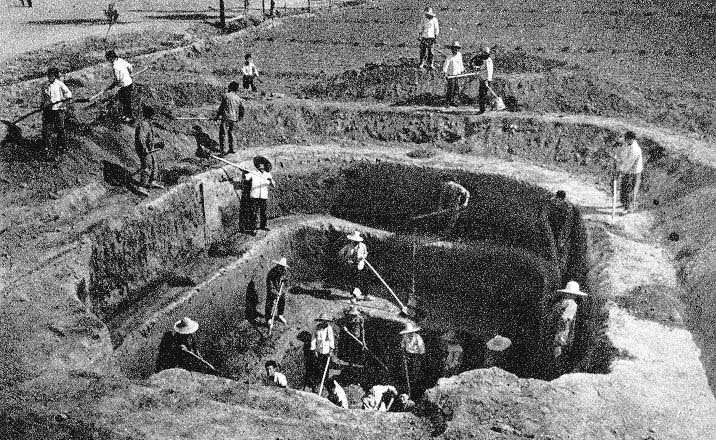
Excavation of Fu Hao’s tomb
Despite Fu Hao’s status in Shang society, she was not afforded a burial in the royal cemetery at Xibeigang where the kings of the last Shang dynasty capital were laid to rest. Instead, and fortunate for us, she was interred in a location where grave robbers did not think to look. Her tomb was discovered 200 meters west of the capital ruins of palaces, temples, and oracle bone archives as well as near several lesser burials at Xiaotun. Unlike the massive tombs in the royal cemetery which were looted in antiquity, Fu Hao’s tomb remained intact until its excavation in 1976. While the immense size of the royal tombs of the Shang kings looms over Fu Hao’s modest resting place, the excavation of her tomb gave us our first true glimpse at the vast wealth of Shang royalty and their lavish burial customs.
Jade ge dagger, Kneeling figure, jade pei, from the Tomb of Fu Hao (Tomb 5 at Xiaotun), late Shang dynasty, 1200 B.C.E., Yinxu, Anyang, Henan, China (photo: Gary Todd, CC0 1.)
Kneeling figure, jade pei, from the Tomb of Fu Hao (Tomb 5 at Xiaotun), late Shang dynasty, 1200 B.C.E., Yinxu, Anyang, Henan, China (photo: Zcm11, CC BY-SA 3.0)
Kneeling figure, jade, from the Tomb of Fu Hao (Tomb 5 at Xiaotun), late Shang dynasty, 1200 B.C.E., Yinxu, Anyang, Henan, China
Fu Hao’s tomb was a vertical earthen pit tomb measuring 5.6 x 4 meters with a depth of 7.5 meters. Archaeologists believe Fu Hao was buried in nesting coffins made of red and black lacquered wood. Her tomb was furnished with some 1,600 burial objects, 16 human victims, and 6 dogs. The dogs were found in a sacrificial pit (yaokeng) at the bottom of the tomb with a sacrificial human victim, while other sacrificial victims were in the outer coffin in niches in the tomb shaft above, and placed on a burial ledge (ercengtai) around the perimeter of the tomb shaft.
The tomb inventory included 468 bronze objects (of which 130 were weapons), 755 jade objects, including Neolithic jades passed down as heirlooms or acquired through import or other means, 63 stone objects, 5 ivory items, 564 bone objects, 6,900 cowry shells, and 11 pottery vessels. [1]
Bronze mirror, from the Tomb of Fu Hao (Tomb 5 at Xiaotun), late Shang dynasty, 1200 B.C.E., Yinxu, Anyang, Henan, China (photo: Gary Todd, CC0 1.0)
Some non-Shang objects, including mirrors and ring-handled knives, found in the tomb suggest Fu Hao may have come from a non-Shang background. However, she may have acquired these objects as loot on her many military expeditions.
Bronze ding with her posthumous title, “Si Mu Xin” inscribed on it (as seen on the rubbing on the right), from the Tomb of Fu Hao (Tomb 5 at Xiaotun), late Shang dynasty, 1200 B.C.E., Yinxu, Anyang, Henan, China (photo: Gary Todd, CC0 1.0
Bronze ritual vessels
Fu Hao’s tomb contained more than 200 bronze ritual vessels, indicative of her social and ritual status in Shang society. 160 of her bronzes were inscribed with her name, meaning “Noble Daughter,” while others were inscribed with her posthumous titles—Queen Xin, Mother Xin, and Ancestress Xin. The latter were cast and used by King Wu Ding, Fu Hao’s sons, and her relatives to make sacrifices to her at her funeral.
The name “Xin” was derived from one of the names of the days in the 10-day Shang week. “Xin” refers to the cyclical day that sacrifices were made to Fu Hao’s spirit after her death.
Reconstruction of the sacrificial altar above Fu Hao’s tomb (Tomb 5 at Xiaotun), late Shang dynasty, 1200 B.C.E., Yinxu, Anyang, Henan, China (photo: Gary Todd, CC0 1.0
Archaeologists believe an open-air structure originally stood above Fu Hao’s tomb where her living descendants continued to appease her spirit through sacrificial offerings come every “Xin” day of the week.
Other bronzes in the tomb were inscribed with the name Queen Qiao Gui, a posthumous title and name of a former royal consort. These were likely bronzes commissioned and used by Fu Hao during her lifetime in sacrifices addressing her maternal ancestress who had the clan name “Qiao” and the posthumous title, or temple/day name “Gui.” Queen Qiao Gui also appears in oracle bone inscriptions. Fu Hao’s husband, King Wu Ding, made sacrifices to Qiao Gui and sometimes asked if Fu Hao should as well. Fu Hao would have used Qiao Gui bronze vessels on the specific “Gui” day to make sacrifices to her ancestor. The vessels were interred in Fu Hao’s tomb so that she could continue to make sacrifices to Qiao Gui in the afterlife. Fu Hao also used vessels inscribed with her own name, but these were not limited in worship to one royal spirit.
This vessel is decorated with frontal taotie with gui dragons used as filler motifs. The flat legs are in the shape of gui dragons as well. Bronze fangding from the Tomb of Fu Hao (Tomb 5 at Xiaotun), late Shang dynasty, 1200 B.C.E., Yinxu, Anyang, Henan, China (photo: Siyuwj, CC BY-SA 4.0). Click here to see the taotie outlined on the fangding.
Bronze jue vessel from the Tomb of Fu Hao (Tomb 5 at Xiaotun), late Shang dynasty, 1200 B.C.E., Yinxu, Anyang, Henan, China (photo: Gary Todd, CC0 1.0)
Fu Hao’s assemblage of ritual vessels included characteristic vessel types of the Shang dynasty, such as a graduated set of forty tripod jue wine pouring vessels, a set of three fangjia, and a set of five fangding vessels.
These vessels are decorated with the characteristic taotie mask, a motif that was ubiquitous in Shang bronze decoration from the middle Shang phase (Zhengzhou period) on.
Bronze owl-shaped zun from the Tomb of Fu Hao (Tomb 5 at Xiaotun), late Shang dynasty, 1200 B.C.E., Yinxu, Anyang, Henan, China (photo: Gary Todd, CC0 1.0)
Bronze guang from the Tomb of Fu Hao (Tomb 5 at Xiaotun), late Shang dynasty, 1200 B.C.E., Yinxu, Anyang, Henan, China (photo: Gary Todd, CC0 1.0)
Innovative vessel types in the shapes of animals, both real and fantastic, were also included in Fu Hao’s inventory. These reveal the ingenuity of Shang bronze casters. Examples include two owl-shaped zun wine containers and an imaginative animal-shaped guang vessel used for pouring alcoholic spirits in Shang rituals.
The guang juxtaposes a composite of a feline and an owl in the design of the vessel. The front portion of the lid of the guang is in the shape of a feline with bared fangs, while the rear portion takes the shape of an owl with round eyes and a pointed beak. The bodies of these creatures extend down onto the vessel proper where we see the limbs of the feline and its long curling tail, and the wings of the owl against a background of squared spirals (called leiwen, or “thunder pattern”). Typical of Shang bronze decoration, profile dragons (gui) and birds are used as filler motifs and the handle is adorned with a sculptural animal head. Hooked flanges running along the ridge of the lid and under the spout of the vessel highlight its curved profile. With the lack of Shang textual references to bronze decoration, the meaning of this rich and imaginative vocabulary of animal imagery is unknown. The decorative vocabulary of Shang bronzes may be purely ornamental, but the connection with the ritual function of the bronze vessels cannot be ignored.
While the lost wax technique was used elsewhere in Eurasia at the time for bronze casting, Shang casters employed a distinctive local piece-mold technique to cast bronze vessels. With the piece mold technique, the caster started with a clay model of the vessel, complete with carved decoration, and then created a piece mold from the clay model that could be used for casting. The piece mold for a round vessel would have two outer sections, a core, and a lid with a siphon for pouring molten bronze into the hollow cavities of the mold. Shang casters never reused the original clay model or the mold, which was broken apart in the casting process. Each bronze vessel found in Fu Hao’s tomb was made from an original clay mold, even those made for matching sets of vessels.
Bronze yue axe from the Tomb of Fu Hao (Tomb 5 at Xiaotun), late Shang dynasty, 1200 B.C.E., Yinxu, Anyang, Henan, China (photo: Augusthaiho, CC BY-SA 4.0)
Fu Hao’s sacrificial axe
Bronze yue axe with a pair of confronting gui dragons, from the Tomb of Fu Hao (Tomb 5 at Xiaotun), late Shang dynasty, 1200 B.C.E., Yinxu, Anyang, Henan, China
Over 130 weapons buried in Fu Hao’s tomb attest to her power and status as a female military leader and ritual practitioner under King Wu Ding. Fu Hao’s tomb yielded four large, flat bronze yue axes associated with the conferment of military authority. Excavated and transmitted texts also attest to the use of yue axes in decapitation rituals, which Fu Hao partook in.
One of Fu Hao’s axes is decorated with a pair of confronting gui dragons, rendered in profile, with their mouths wide open around a floating human head. The iconography is related to the function of the axe as an executioner’s weapon for decapitation but may also be linked to Fu Hao’s status as a consort of Wu Ding. There are only two examples of the motif, and both are connected to Wu Ding’s consorts through inscriptions. [2]
The discovery of Fu Hao’s tomb and the material objects she used in life and death not only corroborated oracle bone inscriptions about this favored royal consort of King Wu Ding, but they also confirmed Fu Hao’s role as one of the most important female military commanders, warriors, and ritualists in the history of ancient China.
Notes:
[1] Robert Bagley, “Shang Archaeology,” in Cambridge History of Ancient China: From the Origins of Civilization to 221 B.C., eds. Michael Loewe and Edward Shaughnessy (Cambridge: Cambridge University Press, 1999), p. 202.
[2] Xiaoneng Yang, ed. The Golden Age of Chinese Archaeology (New Haven and London: Yale University Press, 1999), pp. 176-177.
Additional resources:
Bagley, Robert. “Shang Archaeology.” In Cambridge History of Ancient China: From the Origins of Civilization to 221 B.C., edited by Michael Loewe and Edward Shaughnessy, pp. 124-23 (Cambridge: Cambridge University Press, 1999)
Fong, Wen, ed. The Great Bronze Age of China (New York: The Metropolitan Museum of Art, 1980)
Keightley, David N. “The Shang: China’s First Historical Dynasty.” In Cambridge History of Ancient China: From the Origins of Civilization to 221 B.C., edited by Michael Loewe and Edward Shaughnessy, pp. 232-291 (Cambridge: Cambridge University Press, 1999)
Rawson, Jessica. Chinese Jade : From the Neolithic to the Qing (Chicago: Art Media Resources, 2002)
Yang, Xiaoneng, ed. The Golden Age of Chinese Archaeology (New Haven and London: Yale University Press, 1999)


